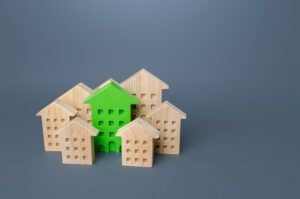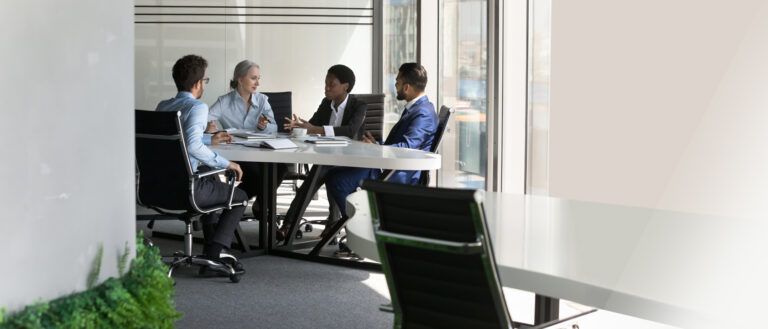How Green Buildings Can Make Indoor Living Sustainable

If we have to fully comprehend the necessity of green buildings, we must go back in time. Twenty five years ago, the great outdoors beckoned us with open arms. We spent our days embracing the sun, feeling the breeze, and connecting with nature. The built environment plays a smaller role in our lives. Yet sheltering us only 50-60% of the time. Back then, this also meant that the number of equipment and their energy consumption were proportionally lower, resulting in a naturally reduced carbon impact.
Fast forward to today, and the narrative has dramatically shifted. A remarkable 90-95% of our time is now spent within the confines of roofs and walls. And our dependence on sophisticated gadgets and power-consuming equipment has increased multifold. This, combined with vertical expansion, has resulted in increased electricity consumption, water demand, and waste generation – eventually translating into higher carbon emitted per square feet compared to any of our previous generations.
The transformation is astounding, and it has brought about a profound change in the way we live. And that makes green buildings built with sustainable building materials a necessity.

The Carbon Impact of Indoor Living
As we’ve embraced indoor living, our carbon footprint has become deeply entwined with our built environment. This connection extends from the carbon emissions involved in construction material production to energy use during the building’s operation. Moreover, even to the carbon impact of demolition or renovation. The numbers are clear: Today, buildings devour roughly 40% of the world’s energy and contribute to 30% of greenhouse gas emissions. This transformation shows that what used to be our sanctuary has become one of the planet’s single largest resource guzzlers. These figures emphasize the urgency of addressing the environmental consequences of our indoor lifestyle.
The Dilemma of Comfort vs. Consumption
This modern conundrum keeps us firmly within the embrace of our indoor structures. The quest for comfort often translates to heightened energy consumption, and it’s a dilemma we grapple with daily. In practical terms, can we really sit inside a building and switch off the air conditioning. This is, especially, true in regions with extreme temperatures? The answer, quite realistically, is no. The indoors must continue to offer us respite from the elements, maintaining a comfortable environment. However, this pursuit of comfort exacts a toll in the form of increased energy usage, which, in turn, contributes to elevated carbon emissions. Balancing this equation between comfort and carbon impact is at the heart of our challenge.
 Navigating the Compromise: Green Buildings
Navigating the Compromise: Green Buildings
The challenge here lies in finding a middle ground—a compromise that ensures both comfort and energy efficiency. This is where the concept of green buildings comes into play, offering a pathway to reduce energy consumption while still ensuring a comfortable indoor environment. Fresh air, a comfortable temperature, and adequate lighting are indispensable for a healthy living and working environment. Green buildings, through their design and operational principles, embody this compromise. By leveraging natural light, promoting ventilation, using energy-efficient appliances, and incorporating smart technology, these buildings lower energy consumption while ensuring a conducive indoor atmosphere.
Sustainable Building Practices: Practical Applications for Carbon Reduction
In green building initiatives, practical applications play a pivotal role in reducing a building’s carbon footprint. In fact, passive architectural design takes precedence by strategically orienting buildings to optimize natural heating and cooling. For instance, for a location in the northern hemisphere, north-facing windows are strategically placed to harvest indirect sunlight without capturing the radiant heat. In contrast, on the southern sides that are exposed to direct radiation, shading elements like overhangs and external louvers are incorporated to block direct sunlight during the hottest periods. Robust insulation in walls and roofs helps maintain consistent indoor temperatures year-round. These passive approaches substantially lower energy consumption and the building’s carbon footprint, exemplifying the power of green building principles.
Additionally, water-efficient measures such as low-flow fixtures and rainwater harvesting systems are effectively integrated into the design. Thus, it curbs water-related carbon footprint. Waste reduction strategies are implemented, promoting recycling and minimizing the carbon impact of construction materials, and this is just the tip of the iceberg. More comprehensive green building practices encompass practical examples that significantly reduce a building’s carbon intensity, contributing to a more sustainable and environmentally responsible future.
The Cumulative Impact of Green Buildings
In a city where every building adheres to green standards, a remarkable transformation can occur. The collective influence of these environmentally conscious structures holds the potential to eliminate the need for additional power plants, thus transforming energy saved into avoided emissions.
This also resonates with the triple bottom line framework, promoting economic, environmental, and social sustainability. These green buildings reduce carbon footprint and contribute to economic growth, environmental well-being, and social harmony. It’s a practical vision where collective action leads to a more sustainable and energy-efficient urban environment.
A Path Towards Sustainable Indoors
In a context where the need to address environmental challenges is increasingly pressing, green buildings and decarbonization emerge as pivotal solutions for sustainable indoor living. In this domain, we achieve comfort without compromising environmental integrity, and each construction component contributes to a sustainable, carbon-neutral built environment.
As we navigate the complexities of modern living, adopting green building practices is not merely an ethical choice—it’s a pragmatic step forward. These practices serve as the foundation for urban sustainability and decarbonization, providing cities with a clear route to a low-carbon future.
NOTE: The views expressed in this article are those of the author and not of Emeritus.





